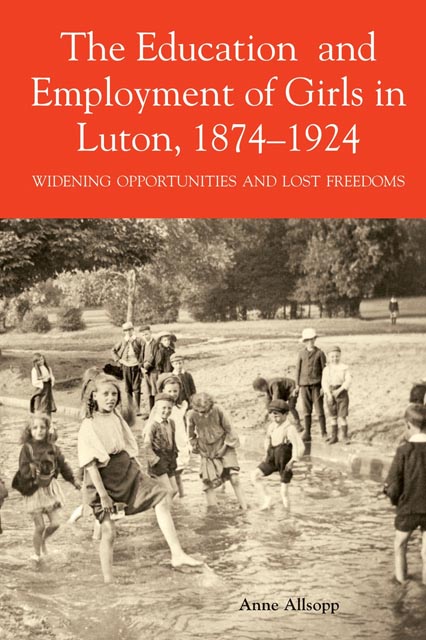Book contents
- Frontmatter
- Contents
- List of Illustrations
- List of Tables
- Dedication
- Acknowledgements
- Abbreviations
- Introduction
- Chapter One Luton: Scientiae et labori detur
- Chapter Two Further Perspectives Concerning Employment Patterns for Women
- Chapter Three Sunday Schools
- Chapter Four Education in the Time of the School Board
- Chapter Five Teaching: An Alternative Occupation
- Chapter Six Teacher Training and the Education of Students Aged Over Fourteen Under Bedfordshire County Council
- Chapter Seven Elementary Education 1903–1924
- Chapter Eight Rural Schools
- Chapter Nine Learning and Living
- Chapter Ten Secondary Education for Girls
- Conclusion
- Appendix
- Bibliography
- Index
Chapter Eight - Rural Schools
Published online by Cambridge University Press: 03 August 2023
- Frontmatter
- Contents
- List of Illustrations
- List of Tables
- Dedication
- Acknowledgements
- Abbreviations
- Introduction
- Chapter One Luton: Scientiae et labori detur
- Chapter Two Further Perspectives Concerning Employment Patterns for Women
- Chapter Three Sunday Schools
- Chapter Four Education in the Time of the School Board
- Chapter Five Teaching: An Alternative Occupation
- Chapter Six Teacher Training and the Education of Students Aged Over Fourteen Under Bedfordshire County Council
- Chapter Seven Elementary Education 1903–1924
- Chapter Eight Rural Schools
- Chapter Nine Learning and Living
- Chapter Ten Secondary Education for Girls
- Conclusion
- Appendix
- Bibliography
- Index
Summary
Schools in the hamlets
In 1895, the Luton School Board was informed by the Education Department and the Bedfordshire County Council (BCC) that the extra-municipal part of the parish of Luton was to be divided into the four rural parishes of Hyde, Leagrave, Limbury-cum-Biscot and Stopsley. ‘It is understood from My Lords’ letter that no change is proposed relative to the area of the Luton Urban District.’ These schools, in what are known as Luton's hamlets, have been a part of the research for this book and, in particular, studies have been made of the logbooks of the Hyde and Stopsley schools. The hamlet schools were under the control of the Luton School Board until 1903 when they became part of the Caddington Group and the responsibility of BEC. Previously, Caddington School, in a village about two miles south of Luton had been managed by the Caddington and Flamstead School Board.
When responsibility was moved to BCC, the Luton Board was asked to nominate four gentlemen
who might be elected to serve on the Body of Managers of neighbouring Rural Schools in future to be controlled by the said County Council. In discussing the matter it was pointed out that such nominations might be (or had already been) made by the respective Parish Councils, and it was resolved that a communication be addressed to the said Parish Councils suggesting that their several nominations might well include the names of Members of this present Board who had acted as Managers of the Schools concerned whilst under the control of the Board.
Rural schools seem to have been considered separately from urban schools, probably for two main reasons: they were frequently much smaller and were in more isolated locations. Although there were also similarities between the schools, especially with regard to the curriculum to be followed, this chapter will concentrate on the character of rural schools and the specific problems which they faced. In particular, these involved the vagaries of the weather and the resulting difficulties with travel, the demands of agriculture, the shortcomings of school buildings, the pressures on staff and the apparent lack of esteem in which rural schools were held.
- Type
- Chapter
- Information
- The Education and Employment of Girls in Luton, 1874-1924Widening Opportunities and Lost Freedoms, pp. 169 - 190Publisher: Boydell & BrewerFirst published in: 2023

